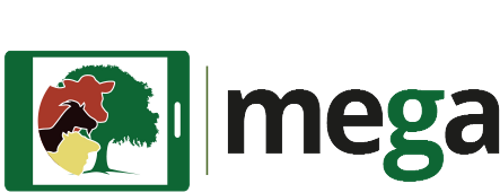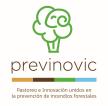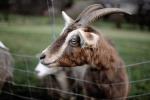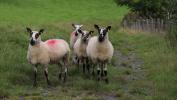
MEGA Operational Group: Improving the efficiency of Andalusian livestock farms
- Type Operational group
- Status In progress
- Execution 2021 -2023
- Assigned Budget 228.019,00 €
- Scope Autonómico
- Autonomous community Andalucía
- Main source of financing CAP 2023-2027
- Project website GO MEGA
Livestock production occupies a strategic position in Andalusia's agricultural sector in economic and social terms. Extensive livestock farming, in particular, in addition to influencing cultural heritage, positively contributes to the natural environment as a sustainable activity that provides enormous benefits, such as the conservation of ecosystems of high environmental value and biodiversity, mitigating climate change, controlling shrub growth and preventing fires, maintaining animal genetic resources, and maintaining population populations in rural areas. Despite being a key component of Andalusia's productive fabric, extensive livestock farming is a highly vulnerable sector due to its dependence on natural resources and the endogenous characteristics of Andalusian livestock farming systems. In this regard, a series of weaknesses and threats are identified that could put the Andalusian livestock sector at risk.
Typically, extensive livestock farming is limited to areas with less agricultural potential due to poor and scarce soil. Climate change, market competitiveness, the depletion of natural resources, and an increase in food demand due to a growing world population, among other threats, are other threats that could put Andalusian livestock farming at risk. Although extensive livestock farming is more vulnerable, these factors also pose a risk to livestock farming and agriculture in general, which must evolve toward a new, much more efficient, sustainable, and optimized production system with the goal of producing more with less. In this sense, improving production efficiency, based on the optimal use of resources, requires data knowledge and analysis to inform decision-making. Data generated during the animal breeding period, which is difficult to analyze due to its variability, is essential. Therefore, digitalized systems and technological advances are required to record and analyze information.
The overall objective of this innovative project is to improve the efficiency and profitability of the Andalusian sheep, cattle, and goat farming sector by providing useful tools for making strategic decisions related to the technical and economic management of livestock farms (technical and economic sustainability). It also aims to improve the quality of life and family life balance of farmers (social sustainability). It also aims to reduce greenhouse gas (GHG) emissions, water consumption, and other environmental resources by improving the productivity and efficiency of herds (environmental sustainability). This is all achieved through the modernization and computerization of the sector. It also aims to implement a communication module that will allow the collection of official data from farmers in SIGGAN and improve communication between the data provided by farmers and the government. Several broader objectives are outlined: - To improve extensive cattle, sheep, and goat production and reduce their environmental impact. -The modernization of the extensive livestock sector, thanks to specific technological developments (web platform and app). -Improving communication between data provided by livestock farmers and the Administration.
In turn, these more general objectives are broken down into several specific objectives, which are the following:
- The establishment of new parameters indicating livestock efficiency.
- Improve the management and environmental efficiency of extensive livestock farming, as well as climate change adaptation and mitigation, by establishing links between the sector and research.
- Preserve biodiversity by contributing to improving livestock farming based on native breeds and the conservation of ecosystems associated with their production.
- Bridging the gap between scientific research and the needs of the sheep, cattle, and goat farming sector. - Training and educating a broad network of livestock farmers in different production systems representative of Andalusia. - Promoting innovation in rural areas.
- Creating added value through a closer relationship between research and livestock practices, as well as encouraging greater use of available knowledge.
Incorporation of new livestock production data into Andalusia's IT management system.
Disseminate and promote the use of the new web platform and app.
Ultimately, the aim is to use new technologies and digitalization to improve the viability of extensive cattle, sheep, and goat farms, as well as their environmental impact. In addition, useful and accurate information will be available during the animal breeding period, which will facilitate decision-making in the livestock sector. Regarding the description of the project activities, a series of indices and indicators will be developed that, using the data currently recorded in SIGGAN, will allow livestock farmers to understand their company's efficiency. A mobile application (App) will be developed to collect SIGGAN data, calculate the proposed parameters and indicators, and make them easily available to livestock farmers/users. A web-based support will be developed that will allow interested livestock farmers to store information beyond that of SIGGAN, helping to improve the calculation of indices and identify unproductive animals. An application interface will be designed to share these indices with other similar applications in the sector, including the administration. Testing of the app in field conditions. Evaluation and comparison of farm results with the new IT system already implemented. Finally, Big Data technologies will be used for information management and analysis, complementing the data already provided by the Andalusian Integrated Livestock Management System (SIGGAN). Development of a web platform and an app will allow the storage and management of generated information in real time, and establish indicators that will determine the efficiency of livestock farming and identify the least productive animals. The expected results will be to advance toward a new extensive livestock production and management model that is much more efficient, sustainable, and optimized, thanks to the use of new Information and Communication Technologies (ICT). Steps will be taken toward the technical and economic efficiency of extensive cattle and sheep and goat farming based on measurable and verifiable data.
Once the background, objectives, actions, and expected results have been defined, another important issue to consider is the expected impact. The potential impacts of the project, and their scope and identity, are assessed as moderate, medium, and high: Improved economic profitability of sheep, cattle, and goat farms in Andalusia, with a high local and regional scope. Modernization of sheep, cattle, and goat farms by incorporating the use of the App into the routine work of farmers, associations, and ADSGs, with a high local and regional scope. Settlement of the rural population and promotion of generational renewal by increasing farm productivity, with a high local and regional scope. Contribution to the sustainability of sheep, cattle, and goat farms by increasing their productivity, with a high local and regional scope. Knowledge transfer to similar livestock sectors, with a medium local, regional, and national scope. As explained throughout these pages, improving livestock efficiency in the extensive sector is a current challenge of great relevance to the sustainability and longevity of the livestock sector in Andalusia. As previously mentioned, the expected results of this project are significant from an economic perspective, thanks to the identification and elimination of unproductive animals, improving the economic performance of livestock farms with similar resource consumption; from a social impact perspective, thanks to the adaptation of Andalusian livestock farming to the challenges associated with market demands and climate change, thereby enhancing the sustainability of the three participating sectors over time and from the perspective of their environmental impact.
Livestock production occupies a strategic position in Andalusia's agricultural sector in economic and social terms. Extensive livestock farming, in particular, in addition to influencing cultural heritage, positively contributes to the natural environment as a sustainable activity that provides enormous benefits, such as the conservation of ecosystems of high environmental value and biodiversity, mitigating climate change, controlling shrub growth and preventing fires, maintaining animal genetic resources, and maintaining population populations in rural areas. Despite being a key component of Andalusia's productive fabric, extensive livestock farming is a highly vulnerable sector due to its dependence on natural resources and the endogenous characteristics of Andalusian livestock farming systems. In this regard, a series of weaknesses and threats have been identified that could put the Andalusian livestock sector at risk. Extensive livestock farming is typically limited to areas with lower agricultural potential due to poverty and soil scarcity.
Climate change, market competitiveness, the depletion of natural resources, and an increase in food demand due to a growing world population, among other threats, can put Andalusian livestock farming at risk. Although extensive livestock farming is more vulnerable, these factors also pose a risk to livestock farming and agriculture in general, which must evolve toward a new, much more efficient, sustainable, and optimized production system with the goal of producing more with less. In this sense, improving production efficiency, based on the optimal use of resources, requires data knowledge and analysis to inform decision-making. Data generated during the animal breeding period, which is difficult to analyze due to its variability, is therefore required. Therefore, digitalized systems and technological advances are required to enable the recording and analysis of information.
Development of a series of indices and indicators that, using the data currently recorded in SIGGAN, allow livestock farmers to understand the efficiency of their livestock. Development of a mobile application (App) that collects SIGGAN data, calculates the proposed parameters and indicators, and makes them easily available to livestock farmers/users. Development of a web-based platform that allows interested livestock farmers to store information beyond SIGGAN, helping to improve the calculation of indices and identify unproductive animals. Design of an application interface that shares these indices with other similar applications in the sector, including those for administration. Testing of the App in field conditions. Evaluation and comparison of the farm results with the new IT system already implemented.
The overall objective of this innovative project is to improve the efficiency and profitability of the Andalusian sheep, cattle, and goat farming sector by providing useful tools for making strategic decisions related to the technical and economic management of livestock farms (technical and economic sustainability). It also aims to improve the quality of life and family life balance of farmers (social sustainability) and reduce greenhouse gas (GHG) emissions, water consumption, and other environmental resources by improving the productivity and efficiency of herds (environmental sustainability).
All this is thanks to the technological and computerization of the sector. Likewise, the aim is to implement a communication module that will allow the collection of official data from livestock farmers in SIGGAN and improve communication between the data provided by livestock farmers and the administration. Several broader objectives are outlined:
- Improve extensive cattle, sheep, and goat production and reduce their environmental impact.
- The modernization of the extensive livestock sector, thanks to specific technological developments (web platform and app).
Improve communication between the data provided by the livestock farmer and the Administration.
In turn, these more general objectives are broken down into several specific objectives, which are the following:
- The establishment of new parameters indicating livestock efficiency.
- Improve the management and environmental efficiency of extensive livestock farming, as well as climate change adaptation and mitigation, by establishing links between the sector and research.
- Preserve biodiversity by contributing to improving livestock farming based on native breeds and the conservation of ecosystems associated with their production.
- Bridging the gap between scientific research and the needs of the sheep, cattle, and goat livestock sectors.
- To train and educate a broad network of livestock farmers in various production systems representative of all of Andalusia.
- Promoting innovation in rural areas.
- Creating added value through a closer relationship between research and livestock practices, as well as promoting greater use of available knowledge. - Incorporating new livestock production data into Andalusia's IT management system.
- Disseminate and promote the use of the new web platform and app.
- Coordinator/entity name: Agri-Food Research and Quality Center of the Pedroches Valley (CICAP)
- Postal address: Dehesa Boyal Industrial Estate, 8, Plots 10-13. 14400, Pozoblanco, Córdoba
- Coordinator/entity email: bpazuelo@cicap.es
- Telephone: 957 116 254
- Centro de Investigación y Calidad Agroalimentaria del Valle de los Pedroches (CICAP)
- Cooperativas Agro-alimentarias de Andalucía (cdiaz@agroalimentarias-andalucia.coop
- COVAP (Cooperativa ganadera del valle de los Pedroches) (jrisquezs@covap.es)
- Nuestra Señora de los Remedios-Picasat (tecnico@remediospicasat.com)
- Cívica Software (jose.morales@civica-soft.com)
- ADSG Altiplano Segureño (bernardo@ancos.org)
- Corsevilla (veterinario@corsevilla.es)
- FADSG (mnudi@fadsg.com)
- Cabra Andalucía (j.fernandez@caprigran.com)
- Centro de Investigación y Calidad Agroalimentaria del Valle de los Pedroches (CICAP)
- News
- Facebook Account of the Operational Group
- Operational Group LinkedIn Account
- CICAP website
- Los Remedios Picasat Website
- Website of the Agro-Food Cooperatives of Andalusia
- Civica Software Website
- CorSevilla website
- Andalusian Federation of Livestock Health Defense Groups
- Cabra Andalucía Website
- Cattle Cooperative of the Pedroches Valley (COVAP)






